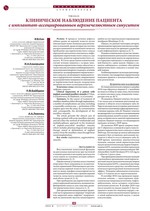Клиническое наблюдение пациента с имплантат-ассоциированным верхнечелюстным синуситом


Научно-практический журнал Институт Стоматологии №2 (99), июнь 2023
стр. 48-50
Аннотация
В процессе лечения дефекта зубных рядов на верхней челюсти путем имплантации может возникать ряд негативных осложнений, среди которых достаточно распространенным осложнением является прободение дна верхнечелюстного синуса верхушкой дентального имплантата, инфицирование верхнечелюстного синуса и, как следствие, развитие верхнечелюстного синусита. В статье представлен клинический случай лечения пациента с острым левосторонним верхнечелюстным синуситом, а также описана методика комбинированного, мультидисциплинарного подхода к лечению имплантат-ассоциированного верхнечелюстного синусита, включающего медикаментозное и хирургическое лечение, направленное на разграничение поверхности имплантата от верхнечелюстной пазухи, посредством введения костного ксенотрансплантата.
Аннотация (англ)
In the course of treatment of maxillary dentition defect through implantation, a number of complications can arise, including a reasonably common one — perforation of the implant apex into the sinus, its contamination and, consequently, the development of the maxillary sinusitis.
The article presents the clinical case of treating a patient with acute maxillary sinusitis and describes the method of multimodal and multidisciplinary approach to the treatment of implant-associated maxillary sinusitis which includes pharmacological and surgical therapy aimed at delimitation of implant surface from the maxillary sinus through bone xenotransplantation.
The article presents the clinical case of treating a patient with acute maxillary sinusitis and describes the method of multimodal and multidisciplinary approach to the treatment of implant-associated maxillary sinusitis which includes pharmacological and surgical therapy aimed at delimitation of implant surface from the maxillary sinus through bone xenotransplantation.
Ключевые Слова
имплантация, синус-лифтинг, синусит.
Ключевые Слова (англ)
mplantation, augmentation, sinusitis
Список литературы
/ REFERENCES:
1. An J.H., Park S.H., Han J.J., et al. Treatment of dental implant displacement into the maxillary sinus. Maxillofac Plast Reconstr Surg. 2017 Nov 25;39(1):35. doi: 10.1186/s40902-017-0133-1.
2. Esposito M., Ardebili Y., Worthington H.V. Interventions for replacing missing teeth: different types of dental implants. Cochrane Database Syst Rev. 2014 Jul; 22(7):CD003815. doi: 10.1002/14651858.
3. Kim S.W., Lee I.H., Kim S.W., Kim D.H. Points to consider before the insertion of maxillary implants: the otolaryngologist’s perspective. J Periodontal Implant Sci. 2019 Oct 9;49(6):346-354. doi: 10.5051/jpis.2019.49.6.346.
4. Lee J.K., Um H.S., Chang B.S. A Retrospective study on the survival rate of the sinus perforated implants. J Korean Acad Periodontol. 2006;36(4):891-900.
5. Ragucci G.M., Elnayef B., Suárez-López del Amo F., et al. Influence of exposing dental implants into the sinus cavity on survival and complications rate: a systematic review. Int J Implant Dent. 2019 Feb 5; 5(1):6. doi: 10.1186/s40729-019-0157-7.
6. Tatum H.Jr. Maxillary and sinus implant reconstructions. Dent Clin North Am. 1986 Apr;30(2):207-29. PMID: 3516738.
7. Zhong W., Chen B., Liang X., Ma G. Experimental study on penetration of dental implants into the maxillary sinus in different depths. J Appl Oral Sci. 2013 Nov-Dec;21(6):560-6. doi: 10.1590/1679-775720130078.
1. An J.H., Park S.H., Han J.J., et al. Treatment of dental implant displacement into the maxillary sinus. Maxillofac Plast Reconstr Surg. 2017 Nov 25;39(1):35. doi: 10.1186/s40902-017-0133-1.
2. Esposito M., Ardebili Y., Worthington H.V. Interventions for replacing missing teeth: different types of dental implants. Cochrane Database Syst Rev. 2014 Jul; 22(7):CD003815. doi: 10.1002/14651858.
3. Kim S.W., Lee I.H., Kim S.W., Kim D.H. Points to consider before the insertion of maxillary implants: the otolaryngologist’s perspective. J Periodontal Implant Sci. 2019 Oct 9;49(6):346-354. doi: 10.5051/jpis.2019.49.6.346.
4. Lee J.K., Um H.S., Chang B.S. A Retrospective study on the survival rate of the sinus perforated implants. J Korean Acad Periodontol. 2006;36(4):891-900.
5. Ragucci G.M., Elnayef B., Suárez-López del Amo F., et al. Influence of exposing dental implants into the sinus cavity on survival and complications rate: a systematic review. Int J Implant Dent. 2019 Feb 5; 5(1):6. doi: 10.1186/s40729-019-0157-7.
6. Tatum H.Jr. Maxillary and sinus implant reconstructions. Dent Clin North Am. 1986 Apr;30(2):207-29. PMID: 3516738.
7. Zhong W., Chen B., Liang X., Ma G. Experimental study on penetration of dental implants into the maxillary sinus in different depths. J Appl Oral Sci. 2013 Nov-Dec;21(6):560-6. doi: 10.1590/1679-775720130078.
Другие статьи из раздела «Клиническая стоматология»
- Комментарии
Загрузка комментариев...
|
Поделиться:
|

 PDF)
PDF)


